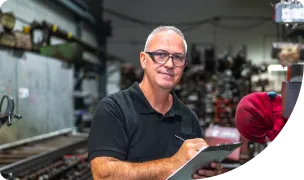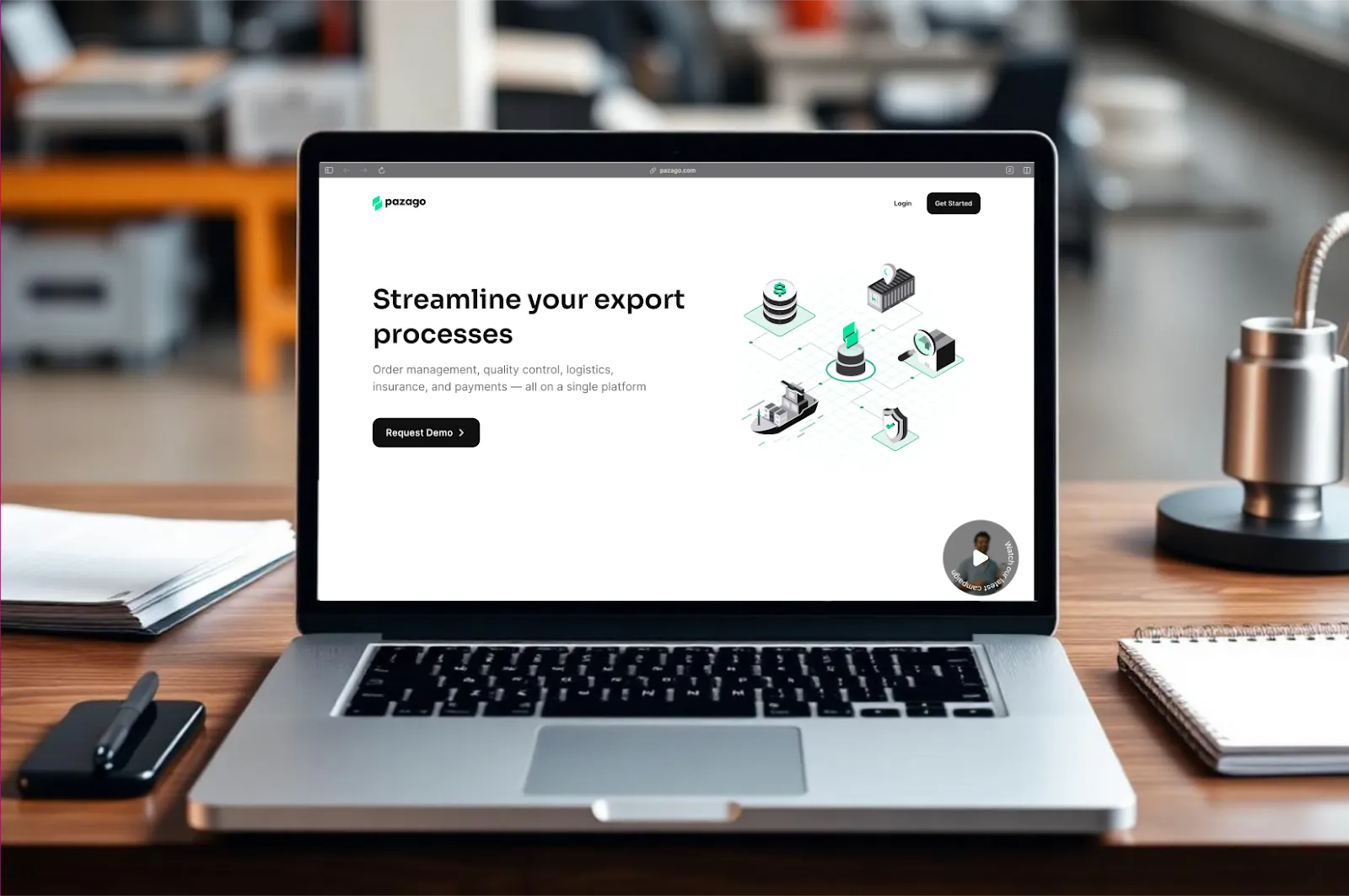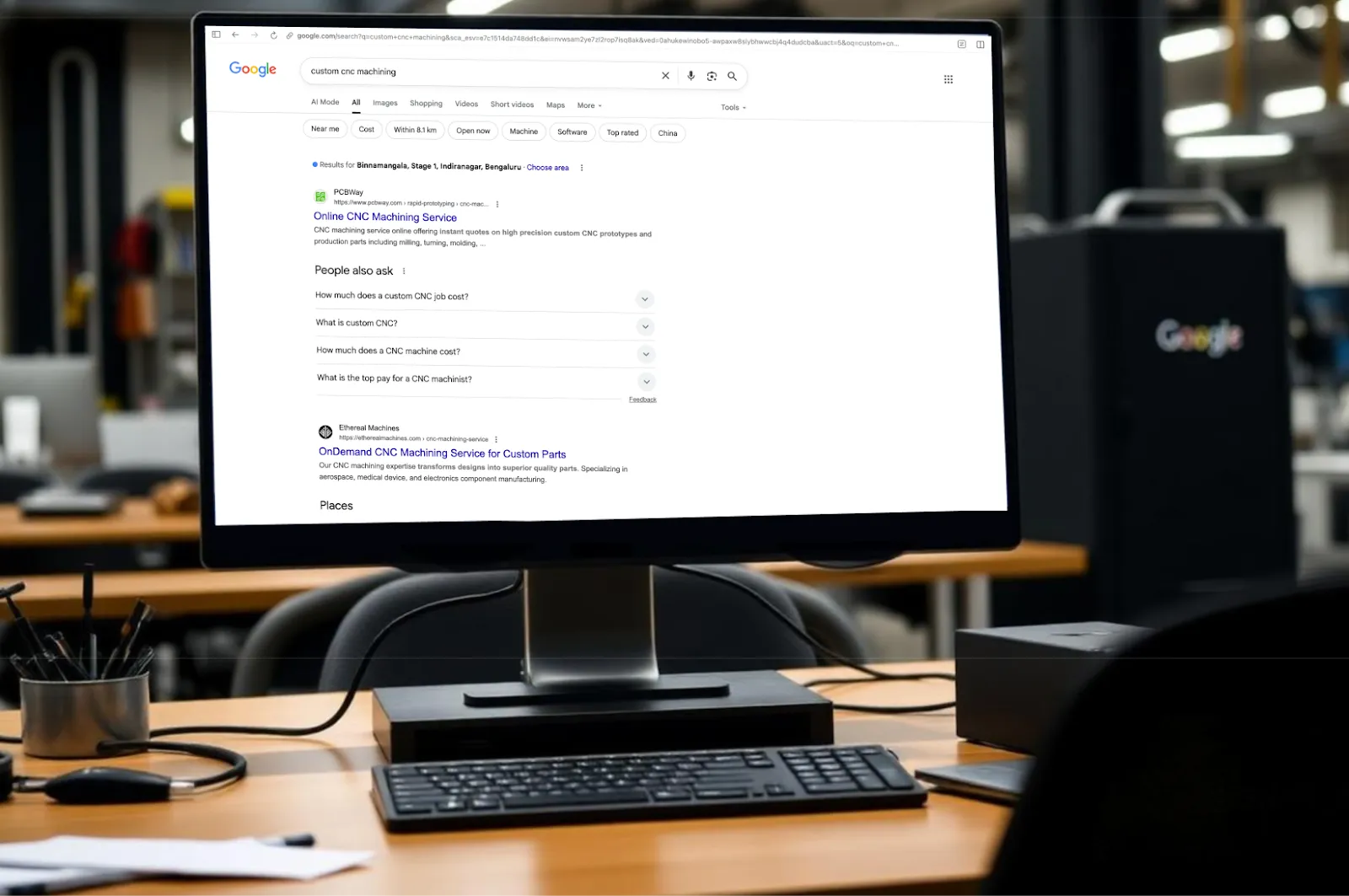Schedule a Call
Get started with your organic growth journey!




B2B manufacturing sales cycles can be long and complex, and a "build it and they will come" mentality simply doesn't cut it.
To thrive, you need a proactive and strategic approach to marketing that consistently generates high-quality leads for your sales team. This isn't about flashy consumer ads; it's about providing value, demonstrating expertise, and building trust with a discerning, professional audience.

Here are some of the most effective marketing strategies for B2B manufacturers to generate leads and drive business growth.
Trade shows are evolving. While everyone debates whether digital marketing is replacing face-to-face events, smart manufacturers are using digital to make their trade show investments work harder.
You already know trade shows work. You've probably closed more business in three days at an expo than most companies generate online all year. But here's what's changed: the buyers walking your booth have already done their homework. They've researched exhibitors online, downloaded case studies, and narrowed their shortlist before stepping foot on the show floor.

The manufacturers dominating trade shows are using digital marketing to control who visits and how ready they are to buy.
Getting on Buyer Research Lists Before the Show
According to the Center for Exhibition Industry Research (CEIR), 76% of trade show attendees research exhibitors online before attending. Your success at the show is decided before the first handshake.
Most manufacturers hope for foot traffic and pray the right buyers find them. Smart manufacturers ensure they're already on the research list of every qualified attendee.
Pre-show visibility strategies:
1. Optimize for "[Trade Show Name] exhibitors" searches: Create dedicated landing pages targeting:
These pages should highlight what you're showcasing, include booth numbers, and offer pre-show meetings.
2. LinkedIn targeting for show attendees: LinkedIn's event targeting lets you reach people who've indicated they're attending specific trade shows. Run campaigns 4-6 weeks before the show to build awareness.
3. Industry publication partnerships: Many trade publications create exhibitor spotlights or buyer's guides.
4. Email outreach to existing contacts: Your current clients and prospects who'll be attending should know you're exhibiting. Send personalized invitations 6 weeks, 2 weeks, and 1 week before the show.
QR Codes to Specific Case Studies
Your booth conversations are limited by time and noise. QR codes let prospects dive deeper into your capabilities without crowding your booth or requiring a sales pitch.

Strategic QR code placement:
Equipment displays: Link to technical specifications, performance videos, or customer testimonials about that specific machine.
Case study posters: Let prospects scan to read the full case study with detailed specifications and outcomes.

Industry application examples: Create QR codes for different industries you serve, linking to relevant project galleries.
Capability demonstrations: Link to longer videos showing the complete process or installation.
Example QR code strategy: A precision machining company had different QR codes for aerospace, medical device, and automotive applications. Each led to industry-specific case studies and capability overviews. They tracked 847 scans over three days and could see that 60% of interest was in medical devices, leading them to focus booth conversations accordingly.
Real-time qualification:
Instead of collecting business cards and hoping, use your booth conversations to qualify and segment prospects digitally:
Hot prospects: Schedule follow-up calls before they leave your booth. Send calendar invitations immediately.
Warm prospects: Add to nurture sequences with relevant case studies and technical content.
Cold prospects: Include in general company updates and industry news.
The real work begins after the show ends. Most exhibitors send generic "thanks for visiting" emails and wonder why nothing happens. Effective post-show nurturing continues the conversation with relevant, valuable content.
48-hour follow-up sequence:
Day 1: Personal thank you email referencing specific booth conversation. Include promised information and clear next steps.
Day 2: Share relevant case study or technical resource based on their expressed interest.
Week 1: Provide additional technical information or invite to facility tour/virtual demonstration.
Segmented nurture campaigns:
For immediate opportunities (projects within 90 days):
For future opportunities (6+ month timeline):
For general interest (no specific project):
Manufacturers who master this digital integration with trade shows dominate them. They're attracting pre-qualified prospects who are ready to discuss specific projects.
Trade Show Marketing 2.0 isn't about choosing between digital and face-to-face, it's about using digital to make every face-to-face interaction count.
Your website is where all other marketing strategies converge. SEO drives traffic to it, Google Ads land prospects on it, trade show leads research you through it, and email campaigns direct recipients to it.

Before diving into optimization, understand that your website serves a different purpose than consumer brands or SaaS companies:
Consumer websites focus on: Impulse purchases, emotional appeals, quick decisions
Manufacturing websites focus on: Technical validation, capability assessment, trust building
Your buyers are asking:
Your homepage has 8 seconds to communicate three things:
Each service or capability needs its own dedicated page that functions like a technical data sheet combined with a case study portfolio.
Essential elements for capability pages:
Industrial buyers are researching during lunch breaks, between meetings, and on mobile devices. Slow-loading websites lose qualified prospects before they see your capabilities.
Common manufacturing website performance issues:
B2B research also happens on mobile devices, but many manufacturing websites are designed only for desktop viewing. Engineers research suppliers during facility walks, procurement teams review options during commutes, and decision-makers browse capabilities between meetings.
Mobile optimization priorities:
SEO is about being found when buyers search “custom conveyor systems food processing” or “precision CNC machining aerospace parts.” In a survey of U.S. manufacturers, SEO was the top-performing channel, because it connects you with buyers already researching solutions.

Your buyers are searching for specific solutions to specific problems:
High-Intent Manufacturing Keywords:
Low-Intent Generic Keywords:
The difference is buying intent. Someone searching "automated bottling line manufacturers California" is likely planning a capital purchase. Someone searching "industrial equipment" could be a student doing homework.
How to find high-intent keywords:
Manufacturing is still a relationship business. Buyers want suppliers they can visit, inspect, and build trust with. That's why local SEO drives some of the highest-converting traffic for manufacturers.
Local SEO wins for a Texas-based custom fabricator: After optimizing for "custom stainless steel fabrication Dallas," they jumped from page 3 to position 2 in six months. Result: 40% increase in qualified RFQs from local searches.
Search is evolving beyond traditional rankings. Google is increasingly pulling direct answers into featured snippets, and AI search tools like ChatGPT and Claude are answering questions without requiring clicks.
This shift toward Answer Engine Optimization (AEO) means your content needs to clearly and completely answer specific buyer questions, not just rank for keywords.
Traditional SEO approach: Target "CNC machining services" with keyword-stuffed content
AEO approach: Answer "What tolerance levels can CNC machining achieve for aerospace parts?" with specific, structured information
How to optimize for Answer Engines:
Google Ads ranked 3rd in manufacturing survey (14% called it most successful), but here's what that statistic misses: the manufacturers using Google Ads correctly aren't treating them as a permanent lead generation engine. They're using them as a testing ground to learn what works, then building sustainable marketing around those insights.

The real value is learning which keywords convert, what messaging resonates, and which value propositions drive action. Then you apply those insights to improve your SEO, website content, and sales process.
The difference between profitable Google Ads and budget-burning campaigns comes down to keyword intent. Most manufacturers target broad terms because they seem to offer more volume. But volume without intent is just expensive traffic.
Example: Why High-Intent Keywords Outperform Broad Keywords
Cost per Lead Comparison (Monthly Budget: $5,000)
The "high-intent" keywords delivered nearly 3x more leads at less than half the cost per lead.
How to identify high-intent manufacturing keywords:
Your competitors' brand names can be some of your highest-converting keywords, if you do it right. When someone searches for "Competitor Name + pricing" or "Competitor Name + alternatives," they're actively shopping around.
Effective competitor targeting approaches:
Direct competitor comparisons:
Competitor targeting best practices:
Your Google Ads might get clicked, but your landing pages determine if those clicks become RFQs.
Fast-Loading, Mobile-Optimized RFQ Forms
Manufacturing buyers research on mobile devices more than you think. Your plant manager might be walking the factory floor when they remember to research that new machining supplier. Your procurement team might be comparing options during their commute.
Essential landing page performance requirements:
Trust signals to strengthen lead conversion:
Provide next steps after they fill out the form like "You'll receive a response within 4 hours during business days. For urgent requests, call [phone number] directly."
Specific Value Props for Different Buyer Types
Manufacturing purchases involve multiple stakeholders with different priorities. Your landing pages need to speak to all of them without becoming unfocused.
For Engineers (Technical Decision Makers):
"±0.0001" tolerances on aerospace components. AS9100 certified with full material traceability."
For Procurement (Financial Decision Makers):
"Reduce part costs 15-30% through design optimization. 99.2% on-time delivery rate over 15 years."
For Operations (Implementation Decision Makers):
"Complete turnkey installation with operator training. 24/7 service support to minimize downtime."
The real power of Google Ads is the insights that improve everything else you do.
What to track beyond conversions:
Monthly ads review checklist:
When you treat Google Ads as a testing ground for insights, you build a smarter, more profitable marketing engine.
In 2022, email marketing ranked as the best-performing marketing tactic for manufacturers and it delivered stronger ROI than any other channel. Yet despite its top results, many teams still underperform because they run campaigns like consumer brands: generic, promotional, and disconnected from how engineers and procurement teams actually make decisions.

Industrial buyers don’t want glossy product templates. They want technical insights that help them solve problems, justify investments, and run operations smoothly. The payoff comes from steady education from your emails that keeps them top of mind until thet are ready to buy.
Content for Engineers vs. Procurement vs. Operations
Manufacturing purchases involve multiple stakeholders, each with different priorities and information needs. Sending the same email to every contact is like using the same cutting tool for aluminum and titanium: misaligned approach, poor results.
As mentioned in the Google Ads Strategy:
The same information needs to be presented differently depending on who's reading it. Engineers want the full technical story. Procurement wants the business impact. Operations wants the practical implications.
Problem Identification → Solution Education → Vendor Evaluation
Manufacturing sales cycles are long because the buying process is complex. Your email sequences need to support buyers through each phase of their journey, not just push for immediate action.
Phase 1: Problem Identification (Months 1-3) Buyer thinking: "We have issues, but not sure of the best approach to solve them"
Email sequence goals:
Phase 2: Solution Education (Months 4-8) Buyer thinking: "We know we need to address this, but exploring different approaches"
Email sequence goals:
Phase 3: Vendor Evaluation (Months 9-12) Buyer thinking: "We're ready to evaluate suppliers and get proposals"
Email sequence goals:
Manufacturing sales cycles often span 12-18 months. Manual follow-up is inconsistent and resource-intensive. Automated sequences ensure consistent touchpoints without overwhelming your sales team.
Stop trying to get immediate responses. Start building relationships with information that makes buyers better at their jobs. When they're ready to make purchasing decisions, you'll be the trusted advisor they call first.
Email marketing does wonders when you are being useful, credible, and top-of-mind when buying decisions happen on industrial timelines. The manufacturers who master this approach build lasting relationships with the technical decision-makers who influence purchasing for years to come.
You've probably been told that "all B2B marketing is the same." Digital strategies that work for software companies will work for you. Here's why that advice keeps burning your budget without filling your pipeline.
Most B2B marketing strategies assume buyers make decisions in 30-90 days with a single decision-maker. SaaS companies love to talk about their "frictionless buyer journey" where someone discovers a problem on Monday and signs up for a trial by Friday.
But when you're selling a $500K automated packaging line or custom-engineered conveyor systems. Your buyers aren't impulse purchasing.
They're planning capital expenditures 12-18 months in advance. The "quick decision" your marketing consultant keeps optimizing for doesn't exist in manufacturing.
A typical manufacturing purchase involves 6-8 stakeholders:
Yet most marketing advice assumes you're selling to one person with one pain point. That's why your "targeted" campaigns feel scattered and your "personalized" content feels generic.
The mistake: Quitting too soon because results aren’t immediate.
How it shows up: A company abandons SEO after three months or Ads after one quarter, constantly restarting instead of optimizing.
How to avoid it:
Here's what most marketing experts don't understand about manufacturing: relationships still matter more than algorithms.
Your buyers might research you online, but they're not buying based on your blog posts. They're buying because they trust you to deliver when their production line goes down at 2 AM.
Generic digital marketing advice treats every interaction like a consumer purchase. "Optimize your funnel." "A/B test your CTAs." "Nurture with email sequences."
But manufacturing buyers want to know the problems you've solved for companies like theirs. They want to touch your equipment, meet your engineers, and understand your service capabilities.
Walk through most manufacturing websites and you'll see the same conversion-killing mistake: "Contact Us for Custom Solutions."
That's not a call-to-action. That's a barrier.
Your buyers are doing research. They're comparing options. They're building technical specifications. And your website is asking them contact details before you've proven you're worth their time.
What buyers actually search for:
What most manufacturers optimize for:
The mismatch is killing your visibility. When buyers are ready to research, they can't find you. When they do find you, your content doesn't answer their specific questions.
Your website needs to work like a technical resource center. Buyers should be able to assess your capabilities, understand your process, and evaluate fit before they ever contact you.
The mistake: Spreading efforts across every channel instead of focusing.
How it shows up: A machining shop launches SEO, Google Ads, email, LinkedIn, and trade shows simultaneously. Three months later, everything is mediocre and the team is exhausted.
How to avoid it:
In most manufacturing companies, "marketing" means trade show booths, product brochures, and lead lists for the sales team. That's not wrong, it's just incomplete.
Sales handles:
Marketing should handle:
If marketing is only a support role, it never drives demand. That means the sales team begins every conversation with no awareness, trust, or momentum.
Google Ads can work for manufacturers. We've seen precision machining shops generate qualified leads at $150 per lead. But most manufacturers use them as a permanent solution instead of a testing ground.
The rental approach (what most do):
The building approach (what works):
Google Ads should tell you what buyers respond to, which keywords convert, and what messaging resonates. Then you use those insights to build something that lasts.
The manufacturers winning in digital marketing are building systems that attract qualified buyers even when they're not actively advertising.
Too many manufacturers treat marketing like a repair job: throw money at it, hope for quick fixes, and abandon it when results aren’t instant. But manufacturing marketing is a system that compounds over time. The manufacturers who win stop treating marketing as an expense and start building it as an asset.

Every month you delay, competitors gain ground. Buyers are searching online, finding alternatives, and building relationships that exclude you.
A $30K trade show that delivers three qualified leads looks expensive. A $2K monthly marketing investment that generates fifteen looks obvious, but only if you build systems instead of chasing quick fixes.
What Success Looks Like
Eighteen months from now, you could be:
Or you could still be hoping your next trade show generates enough leads to hit quarterly targets.
The blueprint is proven. The strategies work. The question is whether you're ready to execute.
.svg)